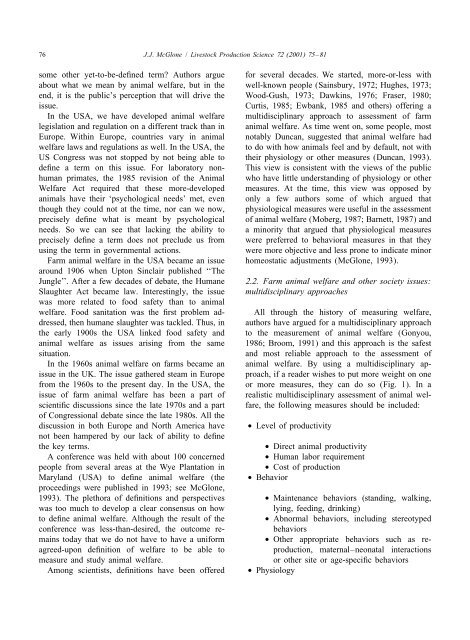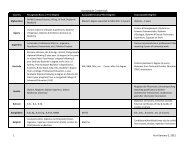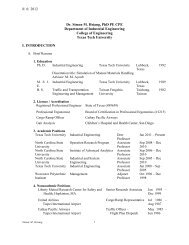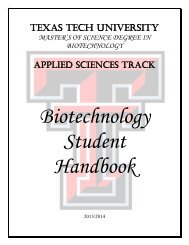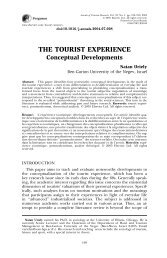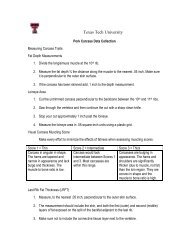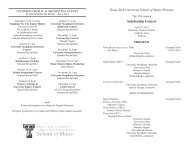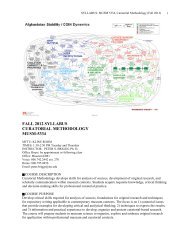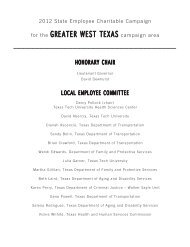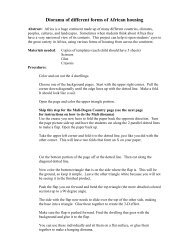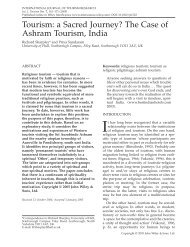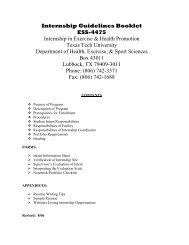Farm animal welfare in the context of other society issues: toward ...
Farm animal welfare in the context of other society issues: toward ...
Farm animal welfare in the context of other society issues: toward ...
Create successful ePaper yourself
Turn your PDF publications into a flip-book with our unique Google optimized e-Paper software.
76 J.J. McGlone / Livestock Production Science 72 (2001) 75 –81<br />
some o<strong>the</strong>r yet-to-be-def<strong>in</strong>ed term? Authors argue for several decades. We started, more-or-less with<br />
about what we mean by <strong>animal</strong> <strong>welfare</strong>, but <strong>in</strong> <strong>the</strong> well-known people (Sa<strong>in</strong>sbury, 1972; Hughes, 1973;<br />
end, it is <strong>the</strong> public’s perception that will drive <strong>the</strong> Wood-Gush, 1973; Dawk<strong>in</strong>s, 1976; Fraser, 1980;<br />
issue.<br />
Curtis, 1985; Ewbank, 1985 and o<strong>the</strong>rs) <strong>of</strong>fer<strong>in</strong>g a<br />
In <strong>the</strong> USA, we have developed <strong>animal</strong> <strong>welfare</strong> multidiscipl<strong>in</strong>ary approach to assessment <strong>of</strong> farm<br />
legislation and regulation on a different track than <strong>in</strong> <strong>animal</strong> <strong>welfare</strong>. As time went on, some people, most<br />
Europe. With<strong>in</strong> Europe, countries vary <strong>in</strong> <strong>animal</strong> notably Duncan, suggested that <strong>animal</strong> <strong>welfare</strong> had<br />
<strong>welfare</strong> laws and regulations as well. In <strong>the</strong> USA, <strong>the</strong> to do with how <strong>animal</strong>s feel and by default, not with<br />
US Congress was not stopped by not be<strong>in</strong>g able to <strong>the</strong>ir physiology or o<strong>the</strong>r measures (Duncan, 1993).<br />
def<strong>in</strong>e a term on this issue. For laboratory non- This view is consistent with <strong>the</strong> views <strong>of</strong> <strong>the</strong> public<br />
human primates, <strong>the</strong> 1985 revision <strong>of</strong> <strong>the</strong> Animal who have little understand<strong>in</strong>g <strong>of</strong> physiology or o<strong>the</strong>r<br />
Welfare Act required that <strong>the</strong>se more-developed measures. At <strong>the</strong> time, this view was opposed by<br />
<strong>animal</strong>s have <strong>the</strong>ir ‘psychological needs’ met, even only a few authors some <strong>of</strong> which argued that<br />
though <strong>the</strong>y could not at <strong>the</strong> time, nor can we now, physiological measures were useful <strong>in</strong> <strong>the</strong> assessment<br />
precisely def<strong>in</strong>e what is meant by psychological <strong>of</strong> <strong>animal</strong> <strong>welfare</strong> (Moberg, 1987; Barnett, 1987) and<br />
needs. So we can see that lack<strong>in</strong>g <strong>the</strong> ability to a m<strong>in</strong>ority that argued that physiological measures<br />
precisely def<strong>in</strong>e a term does not preclude us from were preferred to behavioral measures <strong>in</strong> that <strong>the</strong>y<br />
us<strong>in</strong>g <strong>the</strong> term <strong>in</strong> governmental actions.<br />
were more objective and less prone to <strong>in</strong>dicate m<strong>in</strong>or<br />
<strong>Farm</strong> <strong>animal</strong> <strong>welfare</strong> <strong>in</strong> <strong>the</strong> USA became an issue homeostatic adjustments (McGlone, 1993).<br />
around 1906 when Upton S<strong>in</strong>clair published ‘‘The<br />
Jungle’’. After a few decades <strong>of</strong> debate, <strong>the</strong> Humane 2.2. <strong>Farm</strong> <strong>animal</strong> <strong>welfare</strong> and o<strong>the</strong>r <strong>society</strong> <strong>issues</strong>:<br />
Slaughter Act became law. Interest<strong>in</strong>gly, <strong>the</strong> issue multidiscipl<strong>in</strong>ary approaches<br />
was more related to food safety than to <strong>animal</strong><br />
<strong>welfare</strong>. Food sanitation was <strong>the</strong> first problem ad- All through <strong>the</strong> history <strong>of</strong> measur<strong>in</strong>g <strong>welfare</strong>,<br />
dressed, <strong>the</strong>n humane slaughter was tackled. Thus, <strong>in</strong> authors have argued for a multidiscipl<strong>in</strong>ary approach<br />
<strong>the</strong> early 1900s <strong>the</strong> USA l<strong>in</strong>ked food safety and to <strong>the</strong> measurement <strong>of</strong> <strong>animal</strong> <strong>welfare</strong> (Gonyou,<br />
<strong>animal</strong> <strong>welfare</strong> as <strong>issues</strong> aris<strong>in</strong>g from <strong>the</strong> same 1986; Broom, 1991) and this approach is <strong>the</strong> safest<br />
situation.<br />
and most reliable approach to <strong>the</strong> assessment <strong>of</strong><br />
In <strong>the</strong> 1960s <strong>animal</strong> <strong>welfare</strong> on farms became an <strong>animal</strong> <strong>welfare</strong>. By us<strong>in</strong>g a multidiscipl<strong>in</strong>ary apissue<br />
<strong>in</strong> <strong>the</strong> UK. The issue ga<strong>the</strong>red steam <strong>in</strong> Europe proach, if a reader wishes to put more weight on one<br />
from <strong>the</strong> 1960s to <strong>the</strong> present day. In <strong>the</strong> USA, <strong>the</strong> or more measures, <strong>the</strong>y can do so (Fig. 1). In a<br />
issue <strong>of</strong> farm <strong>animal</strong> <strong>welfare</strong> has been a part <strong>of</strong> realistic multidiscipl<strong>in</strong>ary assessment <strong>of</strong> <strong>animal</strong> welscientific<br />
discussions s<strong>in</strong>ce <strong>the</strong> late 1970s and a part fare, <strong>the</strong> follow<strong>in</strong>g measures should be <strong>in</strong>cluded:<br />
<strong>of</strong> Congressional debate s<strong>in</strong>ce <strong>the</strong> late 1980s. All <strong>the</strong><br />
discussion <strong>in</strong> both Europe and North America have • Level <strong>of</strong> productivity<br />
not been hampered by our lack <strong>of</strong> ability to def<strong>in</strong>e<br />
<strong>the</strong> key terms.<br />
• Direct <strong>animal</strong> productivity<br />
A conference was held with about 100 concerned • Human labor requirement<br />
people from several areas at <strong>the</strong> Wye Plantation <strong>in</strong> • Cost <strong>of</strong> production<br />
Maryland (USA) to def<strong>in</strong>e <strong>animal</strong> <strong>welfare</strong> (<strong>the</strong> • Behavior<br />
proceed<strong>in</strong>gs were published <strong>in</strong> 1993; see McGlone,<br />
1993). The plethora <strong>of</strong> def<strong>in</strong>itions and perspectives • Ma<strong>in</strong>tenance behaviors (stand<strong>in</strong>g, walk<strong>in</strong>g,<br />
was too much to develop a clear consensus on how<br />
ly<strong>in</strong>g, feed<strong>in</strong>g, dr<strong>in</strong>k<strong>in</strong>g)<br />
to def<strong>in</strong>e <strong>animal</strong> <strong>welfare</strong>. Although <strong>the</strong> result <strong>of</strong> <strong>the</strong> • Abnormal behaviors, <strong>in</strong>clud<strong>in</strong>g stereotyped<br />
conference was less-than-desired, <strong>the</strong> outcome re-<br />
behaviors<br />
ma<strong>in</strong>s today that we do not have to have a uniform • O<strong>the</strong>r appropriate behaviors such as reagreed-upon<br />
def<strong>in</strong>ition <strong>of</strong> <strong>welfare</strong> to be able to production, maternal–neonatal <strong>in</strong>teractions<br />
measure and study <strong>animal</strong> <strong>welfare</strong>.<br />
or o<strong>the</strong>r site or age-specific behaviors<br />
Among scientists, def<strong>in</strong>itions have been <strong>of</strong>fered • Physiology


